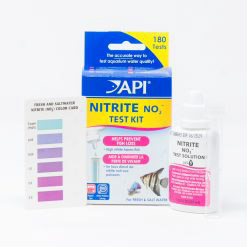Subtotal: $12.60
Ammonia – When the fish eat food, they produce ammonia as waste. At high levels, it will burn the gills of the fish and can cause death. Even at low levels, it can create serious health problems. If the gills get burned, it reduces the fish’s ability to excrete ammonia through the gills, thus causing the ammonia to build up inside the fish quickly. Even low levels of ammonia in a pond for an extended period will cause stress in the fish, thereby lowering its ability to fight off bacterial infections and parasites. For this reason, the only acceptable ammonia level in a pond is always 0.
What can cause a high ammonia level?
Filtration – The pond filter may be inadequate for the pond by either being too small for the fish load or just a poor design. In the case of a new pond, the filter may not have had enough time for the bacteria to develop. In cold climates, the filter bacteria will die back in the wintertime. If you feed the fish too much food in the spring before the filter bacteria have a chance to build back up, you may experience high ammonia levels. Giving the fish a diet high in protein early in the spring or late in the fall can create ammonia because the filter is not up to speed. If you add too many fish to the pond at one time, you can experience an ammonia spike. If you medicate the pond with formalin, potassium permanganate, or several other medications and do not bypass the filter media during the process, you can kill off some of the bacteria in the filter, allowing an ammonia spike. Additionally, if the alkalinity (concentration of bicarbonates) in the water is low (below 50 ppm), this can significantly reduce the ability of the nitrifying bacteria to form.
How do I solve a high Ammonia level?
Water changes are the most effective way to lower ammonia levels. Perform a 25 to 50% water change. Do not forget to add a dechlorinator (Sodium Thiosulfate) to the pond before adding the new water if you are on city water. Check the difference in the water temperature between the pond water and the fresh water. If the difference is more than 10 degrees, add the new water very slowly so as not to shock the fish. Check the ph of the fresh water. Ammonia is much more toxic at a high ph than it is at a low ph. If the fresh water has a ph higher than the pond water, you might want to add a slight amount of acid to the pond to lower the final pond ph after the pond is full to around 7.2. If you suspect that the oxygen level in the pond might be low, add more oxygen. The Nitrosomonas bacteria require oxygen to remove ammonia.
Additionally, if the fish gills were burned by ammonia, adding more oxygen will make it easier for the fish to breathe. Do not forget to check the water’s alkalinity to make sure it is not lower than 50 ppm. Ideally, the alkalinity should be between 90 and 120 ppm. Finally, if the ammonia level is high, stop feeding the fish until the ammonia level drops. I know this is hard for some of you, but you are not helping your fish by feeding them because they use the food to make more ammonia. If the ammonia level is not solved within two weeks, you need to take a serious look at what is causing it.
 Liquid Test Kit - Nitrite
Liquid Test Kit - Nitrite 